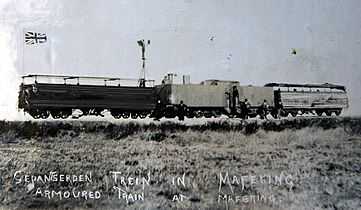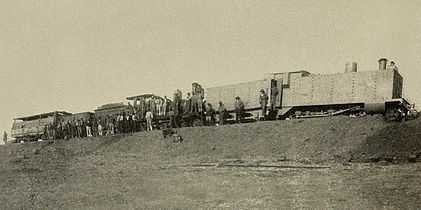CGR 3rd Class 4-4-0 1889
| CGR 3rd Class 4-4-0 1889 to South African Class 03 4-4-0 1889 | |
|---|---|
|
CGR 3rd Class 4-4-0 no. 114 of 1889 | |
| Type and origin | |
| Power type | Steam |
| Designer | Cape Government Railways |
| Builder | Dübs and Company |
| Serial number | 2486-2497, 2536-2547 |
| Build date | 1888-1889 |
| Total produced | 24 |
| Specifications | |
| Configuration | 4-4-0 "American" |
| Gauge | 3 ft 6 in (1,067 mm) Cape gauge |
| Leading wheel diameter | 28 in (711 mm) |
| Driver diameter | 49 in (1,240 mm) |
| Wheelbase |
7 ft (2.134 m) coupled 4 ft 8 in (1.422 m) bogie 18 ft 4 1⁄2 in (5.601 m) engine 10 ft (3.048 m) tender 37 ft 9 1⁄2 in (11.519 m) total |
| Length | 45 ft 8 1⁄2 in (13.932 m) over couplers |
| Height | 12 ft (3.658 m) |
| Axle load | 10 12⁄20 long tons (10.8 t) per driver |
| Weight on drivers | 21 4⁄20 long tons (21.5 t) |
| Locomotive weight | 30 17⁄20 long tons (31.3 t) w/o |
| Tender weight | 27 long tons (27.4 t) w/o |
| Locomotive and tender combined weight | 57 17⁄20 long tons (58.8 t) w/o |
| Tender type | Three-axle, 37 in (940 mm) wheels |
| Fuel type | Coal |
| Fuel capacity | 3 long tons (3.0 t) |
| Water capacity | 1,950 imp gal (8,900 l; 2,340 US gal) |
| Boiler |
3 ft 8 1⁄2 in (1.130 m) inside diameter 10 ft 4 1⁄2 in (3.162 m) length inside 6 ft 1 in (1.854 m) pitch |
| Boiler pressure | 150 psi (1,000 kPa) |
| Firegrate area | 13 sq ft (1.208 m2) |
| Heating surface: – Tubes | 689 sq ft (64.010 m2) |
| – Firebox | 74.5 sq ft (6.92 m2) |
| – Total | 763.5 sq ft (70.93 m2) |
| Cylinders | Two |
| Cylinder size |
15 in (381 mm) bore 22 in (559 mm) stroke |
| Valve gear | Stephenson |
| Performance figures | |
| Tractive effort | 11,365 lbf (51 kN) at 75% pressure |
| Career | |
| Operator(s) |
Cape Government Railways South African Railways |
| Class | CGR 3rd Class, SAR Class 03 |
| Number in class | 24 |
| Number(s) | 93-116 |
| Delivered | 1889 |
| First run | 1889 [1][2] |
The CGR 3rd Class 4-4-0 of 1889 is a South African steam locomotive from the pre-Union era in the Cape Colony.
In 1889 the Cape Government Railways placed twenty-four 3rd Class tender locomotives with a 4-4-0 American type wheel arrangement in service. They were intended for passenger service on the Cape Western System.[1]
Manufacturer
Michael Stephens, who had succeeded Mr. Thornton in 1885 as the Locomotive Superintendent of the Western System of the Cape Government Railways (CGR), drew up detailed designs for a new 3rd Class passenger locomotive for the Western System and placed an order for twenty-four of these locomotives with Dübs and Company in Glasgow. The locomotives, built in two batches of twelve, were delivered early in 1889 and numbered in the range from 93 to 116.[1][2]
These were the first stock locomotives to be built in quantity to detailed designs prepared in the Cape Colony, following the experimental 3rd Class 4-4-0 and 4th Class 4-6-0TT locomotives of 1884.[1]
Service
Cape Government Railways
The locomotives were, at the time, modern and up to date with latest practices and were possibly the most efficient engines in the country. As was usual practice with passenger locomotives on the CGR, they were painted green and had polished brass domes. They were placed in service on the easier sections of the Western System and were used on all types of traffic. On the section between Beaufort West and Kimberley they worked passenger trains successfully, in spite of the poor quality coal from the colliery at Viljoensdrif.[1]
During the Second Boer War from 1899 to 1902 at least one of these locomotives, no. 108, had armour plating fitted to protect the engine and crew from Boer small-arms fire. A photograph below shows no. 108 in armour plating derailed at Kraaipan on 12 October 1899.
By 1904 six of them were transferred to the Midland System and renumbered in the range from 405 to 410. Here they were employed on the line between Port Elizabeth and Uitenhage.[1]
South African Railways
The Union of South Africa was established on 31 May 1910, in terms of the South Africa Act. One of the clauses in the Act required that the three Colonial Government railways, the CGR, the Natal Government Railways and the Central South African Railways, also be united under one single administration to control and administer the railways, ports and harbours of the Union. While the South African Railways (SAR) came into existence in 1910, the actual classification and renumbering of all the rolling stock of the three constituent railways required careful planning and was only implemented with effect from 1 January 1912.[3][4]
All twenty-four locomotives survived to be taken onto the SAR roster in 1912. They were considered obsolete, designated Class 03 and renumbered by having the numeral 0 prefixed to their existing numbers. In SAR service they continued to work on the Uitenhage line on the Midland System and on shunting and light duties on the Western System. Some of them survived until 1923.[2][4]
Works numbers
The works numbers, original numbers and renumberings of the Cape 3rd Class of 1889 are set out in the table.[1][4]
Works no. |
Orig. no. |
1904 no. |
SAR no. |
|---|---|---|---|
| 2486 | 93 | 93 | 093 |
| 2487 | 94 | 94 | 094 |
| 2488 | 95 | 95 | 095 |
| 2489 | 96 | 409 | 0409 |
| 2490 | 97 | 97 | 097 |
| 2491 | 98 | 406 | 0406 |
| 2492 | 99 | 99 | 099 |
| 2493 | 100 | 100 | 0100 |
| 2494 | 101 | 407 | 0407 |
| 2495 | 102 | 102 | 0102 |
| 2496 | 103 | 103 | 0103 |
| 2497 | 104 | 408 | 0408 |
| 2536 | 105 | 105 | 0105 |
| 2537 | 106 | 106 | 0106 |
| 2538 | 107 | 107 | 0107 |
| 2539 | 108 | 108 | 0108 |
| 2540 | 109 | 109 | 0109 |
| 2541 | 110 | 410 | 0410 |
| 2542 | 111 | 405 | 0405 |
| 2543 | 112 | 112 | 0112 |
| 2544 | 113 | 113 | 0113 |
| 2545 | 114 | 114 | 0114 |
| 2546 | 115 | 115 | 0115 |
| 2547 | 116 | 116 | 0116 |
Sides illustrated
The main picture shows no. 114 near Bulawayo in Southern Rhodesia, c. 1900, working on the line from the Cape Colony through the Bechuanaland Protectorate. The following pictures illustrate both sides of the 3rd Class locomotives of 1889.
-

Works picture of no. 96, c. 1889
-

No. 108 in service, c. 1890
-

Armoured 3rd Class 4-4-0 locomotive at Mafeking, c. 1899
-

Armoured no. 108 derailed at Kraaipan, 12 October 1899
See also
- List of South African locomotive classes
- CGR 3rd Class 4-4-0 1883
- CGR 3rd Class 4-4-0 1884
- CGR 3rd Class 4-4-0 1898
- CGR 3rd Class 4-4-0 1901
- CGR 3rd Class 4-4-0 1903
- South African locomotive history
- The 4-4-0 "American"
References
|
- ↑ 1.0 1.1 1.2 1.3 1.4 1.5 1.6 Holland, D.F. (1971). Steam Locomotives of the South African Railways, Volume 1: 1859-1910 (1st ed.). Newton Abbott, Devon: David & Charles. pp. 37–39. ISBN 978-0-7153-5382-0.
- ↑ 2.0 2.1 2.2 Paxton, Leith; Bourne, David (1985). Locomotives of the South African Railways (1st ed.). Cape Town: Struik. p. 17. ISBN 0869772112.
- ↑ The South African Railways - Historical Survey. Editor George Hart, Publisher Bill Hart, Sponsored by Dorbyl Ltd., Published c. 1978, p. 25.
- ↑ 4.0 4.1 4.2 Classification of S.A.R. Engines with Renumbering Lists, issued by the Chief Mechanical Engineer’s Office, Pretoria, January 1912, p. 25. (Reprinted in April 1987 by SATS Museum, R.3125-6/9/11-1000)
